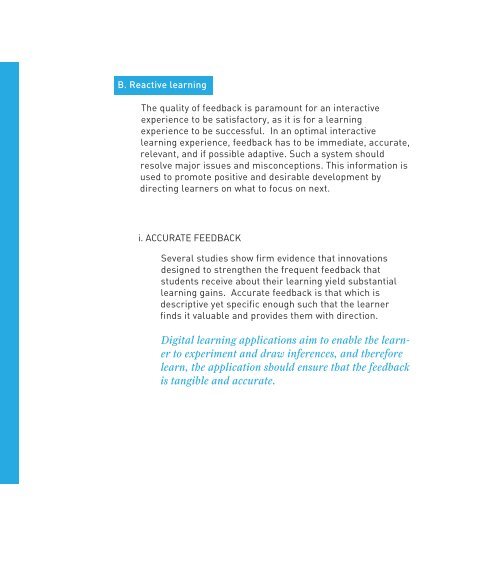Industry Guidelines on Digital Learning: Discussion Draft
The guidelines offered in this document are a first draft to provide a holistic system of characteristics and parameters important for delivering active and engaging learning through digital solutions.
The guidelines offered in this document are a first draft to provide a holistic system of characteristics and parameters important for delivering active and engaging learning through digital solutions.
You also want an ePaper? Increase the reach of your titles
YUMPU automatically turns print PDFs into web optimized ePapers that Google loves.
B. Reactive learning<br />
The quality of feedback is paramount for an interactive<br />
experience to be satisfactory, as it is for a learning<br />
experience to be successful. In an optimal interactive<br />
learning experience, feedback has to be immediate, accurate,<br />
relevant, and if possible adaptive. Such a system should<br />
resolve major issues and misc<strong>on</strong>cepti<strong>on</strong>s. This informati<strong>on</strong> is<br />
used to promote positive and desirable development by<br />
directing learners <strong>on</strong> what to focus <strong>on</strong> next.<br />
ii. RELEVANT FEEDBACK<br />
Relevant feedback is that which is accessible to the<br />
learner in both language and c<strong>on</strong>cepts, allows them to<br />
keep progressing, and ensures they aren’t overwhelmed<br />
by feedback that attempts to correct everything. Hence,<br />
prioritizati<strong>on</strong> by instructi<strong>on</strong> is important. It is important<br />
that both strengths and weaknesses are highlighted so as<br />
to not discourage effort and achievement. ,<br />
i. ACCURATE FEEDBACK<br />
<strong>Digital</strong> learning applicati<strong>on</strong>s should provide relevant<br />
feedback that is acti<strong>on</strong>able and that enables<br />
Several studies show firm evidence that innovati<strong>on</strong>s<br />
designed to strengthen the frequent feedback that<br />
students receive about their learning yield substantial<br />
learning gains. Accurate feedback is that which is<br />
descriptive yet specific enough such that the learner<br />
finds it valuable and provides them with directi<strong>on</strong>.<br />
<strong>Digital</strong> learning applicati<strong>on</strong>s aim to enable the learner<br />
to experiment and draw inferences, and therefore<br />
learn, the applicati<strong>on</strong> should ensure that the feedback<br />
is tangible and accurate.<br />
iii. ADAPTIVE FEEDBACK<br />
Adaptive feedback is that which acknowledges the needs<br />
of the learner, makes them feel more valued, and motivates<br />
them. This allows the applicati<strong>on</strong> to gauge the<br />
learner’s progress effectively and helps to realign their<br />
efforts in accordance with the goal. , .<br />
<strong>Digital</strong> learning applicati<strong>on</strong>s may, depending <strong>on</strong> the<br />
learner’s profile and past acti<strong>on</strong>s/performance, propose<br />
a specific exercise adapted to their needs.<br />
FOREWORD | INTRODUCTION | GUIDELINES | CONCLUSION | AUTHORS & REVIEWERS | REFERENCES<br />
PURPOSE | PRINCIPLES | STRUCTURE | MANDATORY GUIDELINES | RECOMMENDED GUIDELINES


















